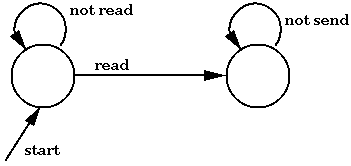
Lecture notes by
Lynette I. Millett
Revised by
Borislav Deianov
Schneider, F.B. Enforceable Security Policies. To appear, ACM Transactions on Information and System Security.
In order to understand which security policies are enforceable, we will postulate a class of enforcement mechanisms (referred to henceforth as EM-enforcement mechanisms). These mechanisms monitor execution and stop it when the security policy they enforce is about to be violated. This class of mechanisms includes virtual memory, reference monitors, capabilities, and UNIX-style access control. It's a very general notion, but it does not include mechanisms that, for example, modify programs or analyze programs prior to execution.
We define a security policy to be a predicate on sets of executions. An execution can be thought of as a sequence of states or instructions. The enforcement mechanisms described above will monitor the sequence (as it is produced). A security policy says what things are not allowed to happen in such sequences. Therefore, a system (for the purposes of this discussion) is defined by a set of executions. If we have a security policy P, and a system (set of executions) S, then the system satisfies the security policy if P(S) = true.
There are some interesting observations to make about these definitions. Suppose that T is a subset of S, and that P(S) holds. Do we want to require that P(T) hold as well? In fact, doing so would cause problems. Consider a system with two variables: s, representing an individual's salary, and x. Assume we are interested in a policy P that says that s cannot be inferred by examining x. The set of all possible executions (of any system) satisfies this policy. However, suppose that T is the set of sequences where s = x. In this case, if it is known that a sequence in T is being evaluated, s can be inferred from the value of x. T is a subset of S, but T violates the security policy P. In short, we don't want to require policies to hold for subsets. However, this means that we can write policies about information flow.
Given these very general notions, and the observations made above, what policies are EM-enforceable? In other words, what are the constraints on P that are consequences of EM-enforceability? We note three:
Almost all of the mechanisms for security that we have discussed this semester are EM mechanisms, including access control, Chinese wall, and policies such as "service is available within three seconds." However, the policy "eventually service is available" is not EM-enforceable. We noted in the last lecture that information flow is not EM-enforceable, either. The properties of security policies listed above encapsulate what are known as safety properties.
All safety properties can be characterized by automata. Here is an example of such an automaton.
